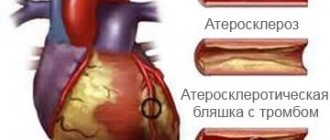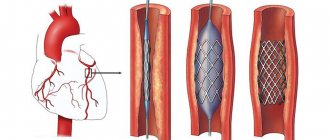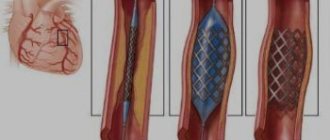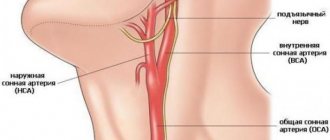The main cause of narrowing of the carotid arteries is atherosclerosis. As the disease develops, atherosclerotic plaques are formed, consisting of cholesterol, calcium and fibrous tissue. They increase in volume, as a result of which the arterial lumen significantly narrows. This disrupts normal blood flow. When the plaque is localized in the lumen of the carotid arteries, cerebral circulation is seriously affected, which can lead to complications and even death. In this case, the patient is indicated for carotid artery stenting.
The cause of age-related changes in the vessels of the neck
Throughout life, the human body is affected by many negative factors. The environment, lifestyle, and foods consumed play an important role. With excessive consumption of foods high in cholesterol, atherosclerotic plaques form. As you age, they grow, causing partial blockage of the arteries, a condition called stenosis.
Another reason for age-related changes in the vessels of the neck is a decrease in the synthesis of collagen and elastin by the body. Vascular tissues become less elastic and more susceptible to negative influences.
What types of stents are there?
A stent is a thin metal frame structure capable of opening and taking the shape of the vessel in which it is installed. Currently, there are more than 300 stent models, but they all have a number of features:
- spring mechanism,
- Mesh design,
- shape memory,
- Coating with a medicinal substance that prevents the formation of blood clots (anticoagulant) or a cytostatic agent that prevents the proliferation of connective tissue,
- No deformation,
- No inflammation at the implantation site.
Symptoms of atherosclerosis
The disease may not manifest itself in any way in the early stages. In most patients, the first sign of pathology is a stroke. But atherosclerosis can be recognized by indirect symptoms:
- feeling of weakness, tingling only on one half of the body (right/left);
- inability to control the motor activity of the arm/leg;
- temporary loss of vision in one eye;
- slurred speech.
Symptoms may subside within a few hours, but this is a warning sign. They indicate a high risk of stroke, so you should consult a doctor immediately.
Indications
The operation is indicated for patients with the following problems:
- significant narrowing of the lumen of the carotid arteries (more than 60%);
- symptoms of stroke, micro-stroke;
- high risk of endarterectomy complications.
The intervention can be carried out even if the patient is not bothered by anything and there are no suspicious symptoms yet. It is extremely important to regularly undergo a comprehensive medical examination in order to diagnose asymptomatic diseases and take the necessary measures.
Medications
Certain medications may also be used under medical supervision to control chronic diseases and prevent blood clots. Your doctor may prescribe aspirin or other blood thinners to be taken daily. He may also recommend taking medications to maintain normal blood pressure, such as angiotensin converting enzyme (ACE) inhibitors (Enalapril), angiotensin II receptor antagonists (Losartan), or calcium channel blockers (Amlodipine). and/or a drug of a number of statins (Simvastatin (Simvastatin)), which lower blood cholesterol levels.
How is the operation performed?
The carotid artery stenting procedure is performed from the femoral approach. The principle of the intervention is similar to stenting other arteries, but there is one caveat. When working with the carotid artery, special protection is used - a filter trap, which prevents destroyed fragments of atherosclerotic plaque from entering small arteries.
Stenting consists of the following steps:
- Installation of a sluice in the femoral artery under local anesthesia;
- The carotid arteries are contrasted using a special substance;
- The issue regarding stenting of one or more affected areas is being resolved;
- A conductor is inserted into the place of narrowing of the artery along the vascular bed, through which a filter-trap is passed;
- Then a stent is inserted into the problem area, which is carefully positioned and secured.
As a result, blood flow in the affected artery is completely restored.
Carotid stenting procedure
Stenting surgery is usually performed under local anesthesia. Before the operation, the patient is connected to special monitoring equipment that monitors parameters such as blood pressure and heart rate.
During surgery, the surgeon usually talks to the patient and also instructs the patient to periodically squeeze a toy or ball to monitor brain function. Some surgeons perform carotid stenting under general anesthesia.
Before surgery, heparin is administered intravenously to reduce blood clotting. The surgical site is numbed with an anesthetic. Before stenting, angiography is performed - an x-ray method that allows you to determine the location of the narrowing of the vessel. After which the stenting procedure begins.
Angioplasty is usually performed before stenting. In this case, a catheter with an inflatable balloon at the end is inserted through the femoral or upper limb artery. The catheter is brought to the site of narrowing of the artery, which is monitored in real time on an X-ray monitor. Next, the balloon is inflated and the lumen of the artery expands. In this case, the patient does not feel pain, since there are no nerve endings on the inner wall of the vessels. At this stage of the operation, the surgeon installs a special balloon, basket or filter behind the narrowing of the artery in order to prevent embolism (blockage) and the development of stroke that occurs as a result of plaques or blood clots breaking off.
After widening the lumen of the artery, a stent is installed using an inflatable balloon. To do this, a compressed stent is inserted into the lumen of the artery using another catheter. Once the stent is at the site previously expanded with the balloon, it relaxes and follows the wall of the artery. To more firmly “implant” the stent into the artery wall, the balloon is inflated again. After this, the catheter-filter device is removed. The stent remains in the lumen of the artery. The entire operation takes on average 1-2 hours, sometimes longer.
Preparing for surgery
The process begins with diagnostic measures. Before the carotid artery stenting procedure, duplex ultrasound and computed tomography must be performed. Depending on the complexity of each specific case, angiography and magnetic resonance angiography may be indicated. A comprehensive examination is aimed at assessing the scale of the problem and the parameters of cerebral circulation.
No specific preparation is required for stenting. All the patient needs to do is take aspirin for a week before the planned surgery as prescribed by the doctor.
Rehabilitation after surgical treatment
Immediately after surgery, the catheter insertion site should be pressed for 15-30 minutes to prevent bleeding. It is also recommended to remain in bed for approximately 12 hours after stenting. During this time, the doctor monitors the patient in order to promptly notice any complications that arise.
If no complications are observed after surgery, the patient is discharged. For some time it is not advisable to:
- lift weights;
- take a bath - you can shower carefully.
Also recommended:
- take blood thinners;
- periodically monitor the condition of the carotid arteries - usually duplex ultrasound scanning is used for this.
Carotid artery stenting in the Group is performed by experienced, highly qualified surgeons. They have modern equipment at their disposal that allows them to conduct informative diagnostics and successfully perform surgical intervention. If you have questions, call us by phone or fill out the feedback form on the website - in this case our manager will call you back.
Contraindications, risk factors
The carotid artery stenting procedure is not performed in the following cases:
- Irregular heart rhythm in the patient;
- Individual intolerance to drugs used during the intervention;
- Brain hemorrhage within the previous 2 months;
- Complete blockage of the carotid artery.
There are a number of risk factors that can lead to complications after surgery:
- High blood pressure;
- The presence of sharp bends and other anatomical features of the vascular bed, complicating the stent placement procedure;
- The presence of large plaques, atherosclerosis of the aorta in the area of the beginning of the carotid arteries;
- Blockages in the arteries of the arms and legs.
In cases where surgery is the only way to save a person’s life, it will be performed even if there are contraindications. However, this requires written consent from the patient or his close relative.
results
- According to the results of the analysis, in patients who had a stent installed in the carotid arteries, the risk of developing adverse cardiovascular events depended on age (p <0.0001). Thus, the frequency was not significantly different in patients under 65 years of age and 65-74 years of age (hazard ratio, 1.3; 95% confidence interval (CI): 0.7-2.3, p = 0.38), but was significantly higher in persons 75 years of age and older (hazard ratio, 2.9; 95% CI: 1.5-5.5, p=0.001).
- But in the endarterectomy group there were no such differences between age groups (p = 0.80).
Possible complications of stenting
ICA stenting is not an absolutely safe operation. The intervention may cause the following complications:
- Embolism of cerebral vessels, which leads to stroke;
- Formation of a blood clot along the installed stent;
- Restenosis is repeated blockage of a vessel. Occurs due to the patient’s failure to comply with the doctor’s instructions after surgery;
- The toxic effect of the contrast agent on the kidneys is observed in patients with acute renal failure;
- Formation of an aneurysm, hematoma in the area of catheter insertion.
Any operation is a risk. But in the case of stenting, the benefits are much greater than the potential complications.
Stenting or carotid endarterectomy?
The October issue of the Lancet published the results of an international randomized trial (International Carotid Stenting Study) comparing the results of stenting and carotid endarterectomy in the treatment of symptomatic carotid stenosis.
1713 patients with symptomatic carotid artery stenosis were randomized 1:1 to either stenting (n=855) or endarterectomy (n=858) with follow-up (mean 4 years). Treatment was carried out in 50 clinics around the world. The “primary endpoint” was death and/or disabling stroke in any region. The results were analyzed using two methods: 1) “from intention to treatment”, 2) including all patients who received the intervention according to the treatment actually received. To assess disability (functional abilities), the modified Rankin scale was used. During follow-up, the rates of death or disabling stroke were not significantly different between the stenting and endarterectomy groups (6.4% vs. 6.5%). The risk ratio was 1.06, 95% CI 0.72-1.57, p=0.77. When analyzed using the intention-to-treat method, stroke (any) was more often recorded after stenting than after endarterectomy (15.2% versus 9.4%). RR was 1.71, 95% CI 1.28-2.30, p <0.001. When analyzed using the actual treatment method, 8.9% versus 5.8%, RR = 1.53; 95% CI 1.02-2.31, p=0.04. Functional activity according to the Rankin scale did not differ significantly between treatment groups. Conclusion: Long-term functional outcomes and the risk of death or disabling stroke are not significantly different between stenting and endarterectomy in the presence of symptomatic carotid stenosis.
Long-Term Outcomes After Stenting Versus Endarterectomy for Treatment of Symptomatic Carotid Stenosis: The International Carotid Stenting Study (ICSS) Randomized Trial
Lancet 2014 Oct 14;, LH Bonati, J Dobson, RL Featherstone, J Ederle, HB van der Worp, GJ de Borst, WP Th M Mali, JD Beard, T Cleveland, ST Engelter, PA Lyrer, GA Ford, PJ Dorman, M. M. Brown
Comments by Dr. med. Professor Samorodskaya I.V.: The results of the study indicate that in the presence of symptomatic stenosis of the carotid arteries, the anatomical and functional features of which make it possible to equally perform both stenting and surgical treatment, equal effectiveness of these methods can be expected. However, one important detail should be added for real clinical practice. When choosing a method, you should consider how much safety is ensured in a particular clinic for the patient when performing both methods. In the event that the skills of clinic specialists in using one of the methods are worse than in the presented study, the treatment results may turn out to be completely different. It should also be noted that the long-term results of stenting may, to a greater extent than the results of surgical treatment, depend on the patient’s adherence to following the doctor’s recommendations (antiplatelet therapy).
Carotid artery stenting after stroke
Surgery is not performed within 2 months after a stroke. After the body recovers and returns to normal, doctors can decide whether to prescribe stenting. Here it is also necessary to weigh all the risks and assess the current state of health of the patient. However, a previous stroke is not a categorical contraindication to endovascular intervention.
Cost of the operation
This intervention, like any X-ray surgical method of treating blood vessels, is possible under a quota within the compulsory medical insurance system. To do this, after establishing the indications for surgery, the attending physician refers the patient for a consultation with a vascular surgeon. If the decision about the operation is made, the doctor collects the necessary documents (examination results, discharge from the hospital, certificates of disability, if any) and sends a request to the regional divisions of the Ministry of Health. After receiving a positive decision from the nearest city or from a health care facility in the patient’s city that they are ready to accept the patient for surgery, the patient awaits a quota. The wait may last for several months, so if he has the opportunity to pay for treatment and stay in this health facility, it makes sense to use paid treatment.
The operation is possible in a multidisciplinary hospital in any large city, provided that this health care facility includes a department of x-ray surgical treatment methods and a department of vascular surgery, and also meets the standards of personnel and technical equipment. The cost of the operation varies from 60 thousand rubles to 200 thousand rubles. The patient must take into account not only the cost of the operation itself, but also the cost of bed days spent in the hospital. The attending physician will advise the patient on a more accurate cost for stenting neck vessels.
Rehabilitation period
Recovery after stenting takes minimal time. The patient will stay in the clinic for 6-24 hours, depending on the current condition. This is necessary so that the doctor can monitor the occurrence of complications. You should drink plenty of fluids for 2-3 days after surgery to flush the contrast agent out of your body. It is also necessary to limit physical activity, follow a diet, and give up bad habits. A healthy lifestyle will help prevent the development of complications and restenosis.
Still have questions about carotid artery stenting?
Free consultation with AngioClinic specialists
Author
Salmina Daria Vladimirovna
Geneticist. Graduated from the Chelyabinsk State Medical Academy. She completed an internship at the Northwestern State Medical University named after I.I. Mechnikov.










